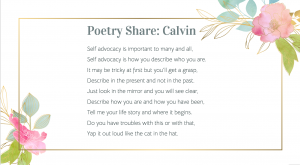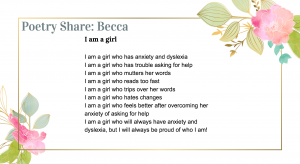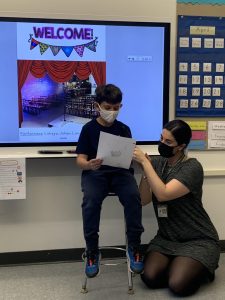 April is National Poetry Month, and it’s a time to celebrate poets and their craft. Students at Gaynor did just that, exploring different types of poetry and various poets.
April is National Poetry Month, and it’s a time to celebrate poets and their craft. Students at Gaynor did just that, exploring different types of poetry and various poets.
In Blue Cluster Head Teacher Chon Smith’s advisory, students spent time each week in April creating poetry.
Students wrote a haiku poem to go along with a diversity, equity, and inclusion lesson on racism against the Asian American Pacific Islander population.
Ms. Smith said because students did a good job with that lesson, she decided to incorporate poetry into their student advocacy curriculum.
“Since they did a great job of being vulnerable during these lessons, I thought poetry would be a good way to show their understanding of what they have learned in student advocacy, specifically self-advocacy, our current unit,” she said.
Ms. Smith said poetry is a great way for students to express themselves without any restrictions.
“Writing is often hard for Gaynor students, but since poetry is a form of art with little rules, students often thrive because they can be free to write without the fear of getting it wrong or worrying about formatting and grammar,” she said.
She said her students are often shy and quiet, but that their written poetry has been excellent.
 “I simply love their work,” she said. “I almost cried reading their honest expressions of themselves and their learning differences. It’s so great that they were able to reflect, give advice, and share their experiences through poetry.”
“I simply love their work,” she said. “I almost cried reading their honest expressions of themselves and their learning differences. It’s so great that they were able to reflect, give advice, and share their experiences through poetry.”
Students also created an acrostic poem for Earth Day and a class poem where each student wrote one line about the weekend that Ms. Smith put together in one, two stanza-poem.
In Blue Cluster Head Teacher Chris Meyer’s advisory, students worked on Golden Shovel poems. Golden Shovel poems honor poet Gwendolyn Brooks and take a line from another poem or text, such as newspaper headlines, and use each word in that line as the end of a line in the poem.
“I liked the use of the newspaper as a source of inspiration,” he said. “I encourage my students to follow the news and keep up with what is happening in the world, so it seemed like a logical activity. The kids were also allowed to use historical headlines, if they preferred, which also appealed to me as a history teacher.”
Before starting the poems, students spent time learning about Ms. Brooks, and how she inspired another poet, Terrance Hayes, to create the rules for composing a Golden Shovel poem as a way to honor her.
Ms. Brooks was a highly respected, talented poet. She was the first African American author to win the Pulitzer Prize, the first Black woman to be a consultant to the Library of Congress, and was the Poet Laureate of Illinois.
“The gist of the activity was that everyone was asked to find a headline that caught their attention,” Mr. Meyer said. “The poems did not have to relate to the story in the paper, but the kids had to use each word in the headline as the last word in each line of their poems. What was surprising to them, and to me, was how profound their poems ended up being.”
Mr. Meyer said that all the poems were thoughtful and deep, and he was impressed by the enthusiasm the students showed while working on them.
He said poetry is a great way for students to express themselves in a creative way that doesn’t conform to the boundaries of proper grammar, mechanics, and even spelling.
“Poets can be more free, in some ways, to open up their creativity, especially when someone might otherwise struggle with the structure of narrative writing,” he said.
In celebration of National Poetry Month, and to practice fluency skills, students in the Pink and Red Cluster have been practicing reading their favorite poems in their reading groups with Reading Specialist Kristi Evans. Students also participated in virtual “Poetry Cafes” this week.
Ms. Evans said one of the things her reading group learned is that poetry helps us feel emotions.
“Every time we read a poem, we plot ourselves on the Mood Meter to check-in on how we are feeling,” she said. “Based on the Mood Meter charting, the poems help students feel pretty good — happy, joyful, and content.”
